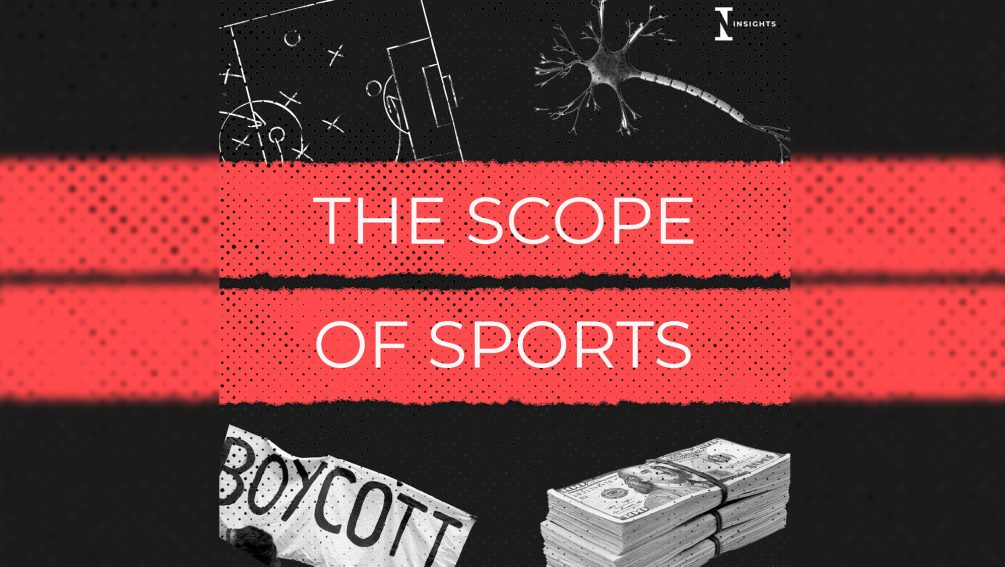Scope of Sports Ep 2: Sports and Branding

Sports teams have grown from institutions created for local communities to practice leisure activities into some of the biggest brands in the world.
We speak to branding expert Professor Gabriela Salinas to find out how this transformation happened and learn what it can teach us about branding in other industries.
© IE Insights.
Transcription
Alex Cope: Sports teams have grown from institutions created for local communities to practice leisure activities into some of the biggest brands in the world. So how did that happen and what can it teach us about branding in other industries?
Hi. We’re here today with Gabriela Salinas, a branding expert and professor at IE Business School. Thanks for joining us today, Gabriela.
Gabriela Salinas: Thank you for the invitation. It’s a pleasure for me to be here.
So today we’re talking about sports and branding. And my first question is a really basic one. What is branding in sports? Are we talking simply about team logos and names or is there something more to it?
So it’s a very interesting question because it opens up a lot of avenues to discuss what is a brand what is not a brand. And that applies to every industry, but in particular to sports. So obviously there is the core of it, which is talking about brands and logos and names and all these tactical elements that we call distinctive brand elements that make a brand distinctive and helps you achieve salience.
That cannot be the full definition of what a brand is, because it leaves out the strategic role of branding. But that is very important because it highlights the importance of achieving consistency and all good brands and sports brands included, master that. But sometimes it goes that we need to take into account the strategic role of branding.
We resort to other definitions of brands which are more applicable to sport or are the typical definitions that you evoke when you think about sports brand, but in particular, a club even more so with a football team which are related to brands as experiences or brands as relationships. Right? And because when you think about sports club or a team, you think about all the feelings and attitudes of the fans and fan engagement.
These two definitions apply particularly well to that. I think nowadays, what is developing as we speak is the concept of brands as financial resources or brands as assets the sheer amount of money that the business is of a sport is generating, this takes center stage.
And if you think about the most valuable brands in sports, and actually Brand Finance publishes every year their Football 50 which is the 50 most valuable brands in football and you look at the top ten which the usual suspects right, it’s Real Madrid and Barcelona and Liverpool and Manchester United, Manchester City, Bayern Munich, and many more.
And what you see is that these brands bolster strength that is similar to Google and Coca-Cola, the biggest brands in the world that have been developing over years. And the typical examples you give of strong brands. And so that gives you an idea of the caliber of these brands and the amount of money that they generate through different sources like broadcasting and commercial, including merchandizing and sponsorship or matchdays.
So understanding the financial impact of brands and the commercial role they play, I think is even more important now than ever and in every industry, but in particular to sports. And actually the role of this report that we publish every year is understanding the financial aspects of the management of brands. But in the case of Football 50, football clubs in particular, because it’s essential to develop a financially successful brand.
And in terms of these massive football brands that you’ve mentioned, Real Madrid, Barcelona, my team Manchester United, a lot of their success comes from success on the pitch. Is there a really strong relationship between success on the pitch and a successful sports brand, or are there more aspects that also play an important role?
So success on the pitch is definitely a very important aspect of the building of a strong brand. And actually if you think about one of the brands that is now in the mouth of everyone, Paris Saint-Germain, they are after winning the Champions League because of that reason it’s almost like the thing that is missing in all their triumphs that they managed to get since they were sold to the Qatari Sports Investment Fund and so that plays a very important role in success on the pitch.
But also everything that happens off pitch is also really important. And this is why now a lot of football clubs and sports teams are investing, for example, in ESG and in developing strong relationships with their communities like Liverpool and La Liga Genuine that gives visibility to people with intellectual disabilities.
So all of these other aspects off-pitch that are related to also the role that the club and the sports plays in culture and how is part of daily conversations and, and pop culture in general are also very important. And I mentioned this brand before, but now, for example, Paris Saint-Germain, and it was bought by QSI, they decided that they would make of the team a lifestyle brand.
They would invest in the brand they would breach sports and culture through many initiatives. And this is an example of how important is not only to have success on the pitch, but also outside the pitch.
And is there anything that you see different between these major sports brands and other brands in terms of something that sports does particularly well? So all big companies do well with their brand. They work hard on their brand they have different techniques. But is there something that sports is particularly well compared to other industries?
I think especially since the influx of a lot of foreign investment in the UK and France with all these Arab investors getting into these countries and China they have obviously a lot of resources and a brand is built on rigorous investment. We have written and we have discussed on IE Insights the importance of having access to a voice and, having presence and visibility and, all this influx of resources has allowed these teams to internationalize and the visibility of mainstream brands has been supported by investment.
So that is something that they do really well. And I wouldn’t say other brands don’t do that well. But is something that these big brands have understood and they have developed products and content and investing in stadiums and improving their fan experience in the stadium.
And going back because this is a club that I really admire as a brand, I have t-shirt, but I cannot say I’m a fan, Paris Saint-Germain, how and the only they invest a lot in all these things, the stadiums, training centers , the squad: the record fee transfer they paid for M’bappe, 222 million on Neymar, Messi.
So they invest in the squad, which is their product. If you think about it they invest in the training centers, in the stadiums, a world class stadiums And not only that, but that has improved the perceptions of the fans and therefore their financial success. Not only that, the way in which they do it and the way in which they realize, well, we are not Real Madrid, we are not FC Barcelona, we cannot kind of brag about our trophies because we are recently and I mean relatively new club founded in the 1970s, but we have other things.
We have our association with Paris, which is the city of lights and the city of love and fashion and design and style, and so we have all those values that we can associate with. And so there was a conscious decision there of we’re going to associate the club strongly to Paris in the new logo and the tower, that they have in the logo.
But also we’re going to activate all those associations through partnerships. And this is something that I think sports brands either are businesses or athletes or sports clubs that I have focused most of my conversation with you on that. But there are different types of sports brands, even events like the Superbowl and all of those have been coming up with agreements and partnerships and alliances and co-brandings that have worked really well.
If you think about Adidas, for example, with Beyonce, that today was terminated because of the lack of sales. But Pharrell Williams and Rita Ora and Bad Bunny and Gucci and Balenciaga and Nike with Tiffany’s and Ben and Jerry’s and these guys Paris Saint-Germain with premium fashion designers, right.
And they were featured in the Paris Fashion Week. Right? So they want to be part of that kind of like culture, street fashion and being the bridge between sportswear and lifestyle. And then in 2018 they signed this amazing agreement – for me from a branding point of view – with Nike’s Jordan brand. And so in their T-shirts they feature both their logo and the Jordan logo.
And they said, it’s a great way of reaching people that not necessarily are interested in football, but they were maybe more interested in basketball or Jordan himself or street style and into lifestyle and very interesting fashion. And they thought this is a really cool item to buy. And I will add it to my wardrobe.
Right. So I think in that sense, investing in the brand, but also kind of cracking the code of partnerships and making brand for the culture and making ecosystems for the brands even now they are going further than that. And for example, and again, Paris Saint-Germain did this promotion in partnership with Warner Brothers for Justice League.
They had all their squad being part of that promotion and also with the Minions. Right. Which are unlikely partners of football but that are part of pop culture. Right. And then and when the Rolling Stones went to Paris, returned to Paris, they did like this limited edition T-shirts of Paris Saint-Germain with the logo with the tongue out of the Rolling Stones, which is, again, being part of that conversation, being part of culture.
And I think that is a very interesting approach. That in particular, Paris Saint-Germain, but many other sports brands outside football like I mentioned, Adidas and Nike, have taken and I think they have been quicker being ahead in terms of these partnerships.
Teams like Paris Saint-Germain, Barcelona, Real Madrid, they come from glamorous cities and that’s in their identity. These are big capitals, or in the case of Barcelona, a glamorous Mediterranean city. But nearly all sports teams have a town or a city in their name. And it’s a clear part of their identity. So how much do teams and clubs have to ensure that their brand retains a local feel, or should they always focus on a more international audience?
I think the quickest path to growth nowadays for sports brands and any type of brand is internationalization, right? So I think although there is a role for the local relationships and giving back to the community and playing a role in the lives of elders and children and youth and still you can retain that local flavor, making sure that is apt for consumption in an international market.
So a club that do that really well I think is Atletico Madrid, which it was a relatively – not because of following – but a small team in terms of results or they didn’t have results on the pitch and then they got foreign investment and they started to internationalize. And they brought bigger international players and started to get results on the pitch. But they made sure that their values of before. It was funny, I read research that said that Atletico Madrid fans, instead of Fanta, they consume Kas, instead of buying Samsung TVs, they bought LG.
So they almost want always the underdog. And it’s almost like their identity, because before Cholo Simeone they didn’t used to win that much. But that changed, when they internationalized so in a way and you still keep your links to Madrid and I wouldn’t say Atletico is a small team, it’s a big team. But in order to become international, you need to acquire the visibility and the flexibility in terms of positioning that you need for international markets and some things about the Colchoneros could be part of your narrative and history. I mean, something you could use as a platform internationally.
Sports, of course, are not just constrained to teams and clubs, but also nations.
So how important can sports play in the branding of a nation? You’re from Argentina and congratulations on the World Cup win. And we’ve seen how much it almost united the country and how much a role football plays there. But in general, how important can sports be in this brand for a nation?
I think it’s very important, the role of sports in general. And that countries that are known for certain sports, like, for example, India, for cricket and then Argentina and Brazil for their football, England too, so it’s important. But actually we are going to find, as we study this in a systemic or with a global perspective, we study soft power. And we define soft power, which is basically nations branding name in layman’s term, as the ability of a nation to influence other actors in the international arena.
Other corporations, other governments, diplomats and not so much through coercion, but rather through attraction and persuasion. So it’s attractive power. Let’s say. So Singapore, they don’t have much of the others, but it has a lot of attraction power. Right. And so this is independent of your size and your economy and you’re not a military power.
It doesn’t matter. You have other ways to influence. And so when we measure that and we follow the model of Professor Joseph Nye that has defined this concept, an American professor. So we define it as how well-known a country, a nation is, in the international arena. So familiarity and how well-regarded that country is, so their reputation, and how much influence that nation can exert in the international arena, positive, and it’s also underpinned by, other perceptions that are related to their business and trade.
So how easy it is to do business in that particular country, the tax system, bureaucracy and all of those things in the relationship to business, and how good their products and services are and the international relations: so diplomacy and everything that has to do with government corruption and the institutions, how strong they are, media and communications that are free.
But one important pillar among all of these is cultural heritage. And one of the sub-pillars of cultural heritage is arts and entertainment, which is closely related to sports, but also being leaders in sport. So, if you look at which countries are leaders in sport, in the latest ranking that we published in February this year, we did a big event in London and the results were announced there.
You find two developed countries which are USA and Germany, and then 200 emerging countries like Brazil and Argentina, although we have been emerging for a long time. But the thing is obviously sports puts you on the map and has that capacity like Nelson Mandela used to say of uniting people.
It’s almost like a common language, sometimes you don’t to speak a language, but you go to a football match and you’re with someone the doesn’t share your values, your culture and your all understand the rules. And there always is a common language that has the power to inspire, to provoke a deep emotion, especially in Argentina and countries like Brazil, that is part of our national identity.
And actually now when we see where the World Cup was hosted which was in Qatar, I think Qatar and Saudi Arabia are current modern examples of how sports can be used as a tool of diplomacy. And actually there is professor that I really admire, he is a British professor that now lives in France.
He has been studying sports over decades. And he says, well, the role of sports has shifted from being a public good that was played in England post-industrial revolution purely as leisure. And then we enter this neoclassical era in football in particular after 1992, the Brand Beckham, so sports as a private good to actually make money and clubs started to form in these decades. And now we have entered a new stage in the development of sports brands which is sports as a geopolitical economic asset.
Where these big countries and governments use sports as these tools of diplomacy, which it became apparent in this World Cup and where a lot of ‘clasicos’ are hosted in Riyadh, in Argentina the ‘Junta’, the dictatorship, hosted the World Cup there because it was an exercise of trying to build on a rather poor reputation for the country at that point.
So I think definitely they are a powerful tool to build a nation’s brands also to building bridges with other countries. So, for example if you see South Africa, then they have the best influence, perceived influence or reputation in New Zealand, and it’because they have these common sports: rugby.
And also everyone knows where Twickenham is, because they play rugby, it’s a city of rugby, so it builds bridges also and common languages and codes between countries. So I think that’s another role of kind of diplomacy.
And you mentioned sports moving into a new era. Do you think branding in sports is also with new media, new technology, we’ve seen a lot more social interaction between sports stars, sports athletes, sports clubs and fans. Do you think this is something that’s a short-term fad or are we seeing a new world of interaction that’s going to continue into the future?
I think definitely all thid new media and the window that it gives us into the lives of particular athletes or that we’re particularly interested in is here to stay. And for example I follow Aston Villa, right, just because Emiliano Martinez plays there – Dibu – and I see now the time he goes to train and if it’s cold or if it’s raining, and codes that they have in terms of communications things that I wouldn’t have had access to before.
You had to be very close to that club to understand what the codes are. So that gives also an opportunity for athletes. So, for example, if you go and see Ronaldo is the most followed celebrity in the world. He has something like 570 million followers and Messi 450. And so they almost are media channels in themselves, right?
And they don’t depend on other people to channel a message or convey a message or to present themselves into the world. They can choose exactly how they do it. And so that gives tremendous power to them to build brands. But also to rethink or do we need to communicate more maybe in English, more to women, those kinds of important definitions when you communicate the brand.
Maybe they need that, I see some players sometimes they say maybe you should communicate more in other languages. Maybe all these messages are very good, but you’re not going to attract a female following with this. Things like that that probably need some exercises of reflection.
But definitely I think it helps a lot with the relationship with the fans because it helps you kind of warm up for the match or the event whatever is coming. You can have the pre-match and also you enjoy the match with all the communications and highlights and then the post-match analysis.
And so I think it really helps going hand-in-hand with the fan throughout the journey and enhance the experience. And I think most clubs and leagues understood that and are doing a superb job in that.
And it comes back to what you said at the beginning about brands as experience and it’s becoming to become a more encompassing experience for all, I imagine. Okay. Well, thanks a lot for being with us today, Gabriella. It’s been really interesting.
Thank you for the invitation and I hope to be back soon.










